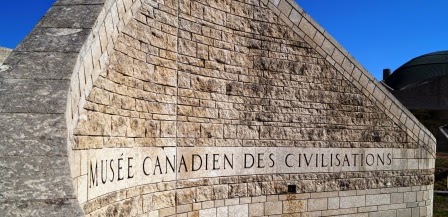We welcome you
to come along as Ontario Visited Tours the Canada
Agriculture and Food
Museum … continues … Cows,
Milking Time, Touch Carts!
 |
Canada Agriculture and Food Museum
"Resting Time" |
 |
"Milking Time"
Canada Agriculture and Food Museum |
The Cows …
Although natural breeding occurs on
a majority of beef farms, the Museum
uses artificial insemination. The gestation period is approximately nine
months, and Dairy cows have their first calves at two years. Calving season for
the beef cattle industry is January to April. As we walked through the beef paddock there were about 12 cattle, one of each breed. As their name implies, beef cattle are those breeds raised for their
meat. The Museum is home to Canada’s most
popular beef cattle breeds.
They have a cow
"shower" which is fun for visitors to watch. We mentioned to Kelly about our friends at the Lindsay Agricultural Society who have a
sign in their "washing station" ... "cattle only" ... but, on
many occasions we see goats and horses being washed and showered. I guess the
cattle and horses/goats can share the different wash stations though.
Milking Time …
It was time to
head out to the barns. The Museum’s
working dairy barn is home to a herd of 40 to 50 dairy cows. This herd is made
up of the six most common dairy breeds in Canada. To keep milk production
consistent, the Museum has cows at
different stages of gestation year round. Maternity pens change occupants
regularly as expectant cows are watched for signs of labour and new calves are
born.
As Kelly talks about the care and feeding
of the animals, here is an example of how specific the Museum is …
The average dairy cow eats
around 10 kilograms (22 pounds) of food each day. This is divided evenly
among hay for roughage and oats, soybean meal, and oil cake for protein. (Oil
cake is ground flax or soya beans from which the oil has been removed.) In
addition, each cow drinks a bathtub’s worth of water each day — more if it’s
hot!
The Museum staff milk
the cows twice daily (6 a.m. and 4 p.m.). They use a modern milking machine
that takes 3 to 5 minutes per cow, versus the 10 to 15 minutes hand-milking
would take. Cows are milked 305 days a year and rest the other 60 days in the
final months of gestation. The Museum’s milk
goes to Dairy Farmers of Ontario to
be processed and distributed in grocery stores. Visitors are invited to watch
the 4 p.m. milking.
Touch
Carts …
 |
"Touch Cart"
Canada Agriculture and Food Museum |
The Canada
Agriculture and Food Museum has mixed breeds of all their animals.
Visitors are welcome to experience all that is happening during their visits.
If a birth is happening, you are welcome to watch. They have “Touch
Carts” at each barn station where workers demonstrate what happens in
each area. From medical equipment to feeding tools, to grooming tools. Usually
there is something to watch every ½ hour. The only standard demonstration are
the dairy cows, they need regular milking at 6 a.m. before the visitors arrive,
and 4 p.m. Nature wont wait. These cows produce about 2600 liters of milk. The Museum is under an “educational quota”,
meaning that this “protect” the CAFM somewhat from the financial
penalties of being over.
They keep the momma’s about
to give birth as “dry cows”. To make sure no one accidentally mixes up what
“stage” the cattle are in, they put tags on their legs. Green is for “dry cow”,
other colours indicate a birth is coming soon; Red is an indication to not put
milk in the bulk tank. With their breeding process, if a male if born, it
obviously can not be used for dairy. It usually is sold for veal. It was
interesting to see bars just at the top of each cow back in the stall. We asked
Kelly what they were for. She told us
that when the cows go to the bathroom, they usually arch their backs. The bar
stops them from doing so. They then step back a bit allowing their “toilet
issues” to drop into the “potty toughs” behind them. This helps keep their
areas clean and dry.
Stay tuned for
more “Behind the Scenes” Tour with
the Canada Agriculture and Food
Museum ~ The Sheep, Summer Camp & Fun! (in the meantime,
check out their great website for lots of fun and information at http://cafmuseum.techno-science.ca/en/index.php.)











